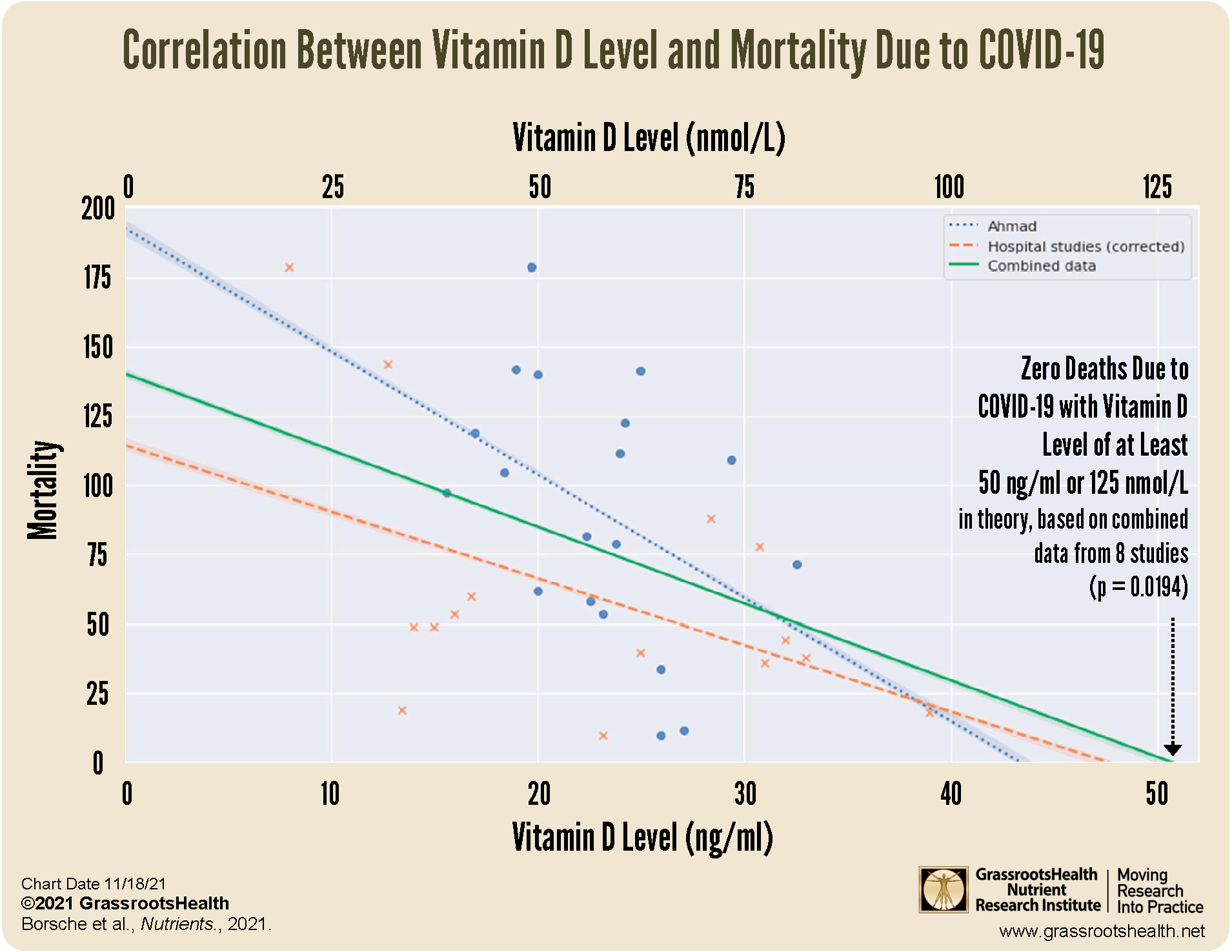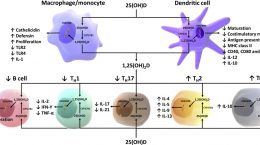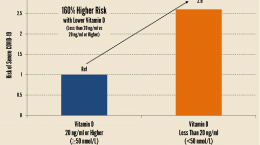Published on November 18, 2021
A systematic review and meta-analysis of 8 studies confirms an inverse correlation between COVID-19 mortality and vitamin D levels
Key Points
- A new meta-analysis shows that as vitamin D levels increase, COVID-19 mortality decreases, to a point where the projected mortality rate reaches zero at around 50 ng/ml (125 nmol/L)
- There is much evidence that low vitamin D3 is a predictor rather than just a side effect of infection, and that “a fatal outcome from COVID-19 infection, apart from other risk factors, is strongly dependent on the vitamin D status of the patient.”
- Measuring vitamin D levels is necessary to ensure a target level has been reached with supplementation
 A review by Borsche et al. used data from 8 different studies (one population study and seven clinical studies) to determine a potential optimal vitamin D level to minimize COVID-19 mortality. This analysis is titled COVID-19 Mortality Risk Correlates Inversely with Vitamin D3 Status, a Mortality Rate Close to Zero Could Theoretically be Achieved at 50 ng/ml 25(OH)D3: Results of a Systematic Review and Meta-Analysis.
A review by Borsche et al. used data from 8 different studies (one population study and seven clinical studies) to determine a potential optimal vitamin D level to minimize COVID-19 mortality. This analysis is titled COVID-19 Mortality Risk Correlates Inversely with Vitamin D3 Status, a Mortality Rate Close to Zero Could Theoretically be Achieved at 50 ng/ml 25(OH)D3: Results of a Systematic Review and Meta-Analysis.
The chart below illustrates the data to very clearly show how, as vitamin D levels increase, mortality decreases, to a point where the projected mortality rate reaches zero at around 50 ng/ml (125 nmol/L) of vitamin D.
We highly suggest reading this paper, however, below is a summary and a quick video review by Dr. John Campbell, PhD, who created two different reviews of this paper – one is a short summary version (below) and the other (Part 2) goes into further detail.
Watch the Video
The video below is a quick review of this paper and its findings. Please also read through the summary and added notes after watching the video.
For an in-depth video review by Dr. Campbell, watch Part 2 here.
The Conclusion Says it All
As the authors of this paper conclude,
“The datasets provide strong evidence that low D3 is a predictor rather than just a side effect of the infection. Despite ongoing vaccinations, we recommend raising serum 25(OH)D levels to above 50 ng/mL to prevent or mitigate new outbreaks due to escape mutations or decreasing antibody activity.”
How Do You Get Your Vitamin D to 50 ng/ml (125 nmol/L)?
As also outlined by the authors, testing vitamin D levels before starting a new supplementation plan, combined with taking note of health history and other health factors (such as digestive health, recent illness, medications, etc.), can help provide clues as to how the individual may respond to vitamin D supplementation and if higher doses of vitamin D, or other co-nutrients, may be helpful in achieving a level of 50 ng/ml. Several conditions and diseases, such as autoimmune diseases and cancer, may call for a higher target vitamin D level. Knowing the current level and what an appropriate target level is for each individual are just two steps towards reaching and maintaining a minimum vitamin D level. After calculating a new dose of vitamin D and/or implementing a new vitamin D routine (such as including indoor UVB or sunshine exposure into daily habits), testing levels again after 2-3 months is essential in order to see if the target has been met. If not, re-evaluate to see what may need further adjustment, and repeat. These steps are further outlined here.
Remember that, while an extra 4,000 to 10,000 IU of vitamin D may be needed per day for some individuals to reach their target level, it may be too much for others. This is another reason testing is important. Vitamin D is safe and toxicity is difficult to achieve, however, toxicity can be seen with vitamin D levels above 200 ng/ml (500 nmol/L). Measuring levels and getting enough co-nutrients (such as magnesium and vitamin K2) can help avoid potentially negative effects of supplementing with higher doses. (In regards to vitamin K2, the authors of this paper recommend getting 200 mcg per day along with vitamin D.)
Participating in the GrassrootsHealth Vitamin D*action project gives participants a platform to measure vitamin D levels from home and track results along with health, supplement, and lifestyle data, all while contributing to vitamin D research. We call it Citizen Science… Join Today!
Vitamin D is Essential for Proper Immune Function
“One strong pillar in the protection against any type of virus infection is the strength of our immune system… this unquestioned basic principle of nature has been more or less neglected by the responsible authorities.”
Immune cells rely on vitamin D for specific functions. Intracellular vitamin D3 receptors are found in almost all cell types involved in the immune response, including monocytes/macrophages, T cells, B cells, natural killer (NK) cells, and dendritic cells (DCs). With vitamin D being necessary for all stages of the immune attack, the body’s demand for vitamin D increases from the time the body is exposed to a pathogen, throughout the immune response. This need cannot be met if vitamin D levels are too low to start, and if left uncorrected, could be a cause for poor outcomes.
Vitamin D deficiency
- limits immune system performance
- increases the spread of diseases
- reduces protection against infections
- reduces effectiveness of vaccination
- is a main cause of severe COVID-19 illness
Vitamin D status correlates with
- length of ongoing COVID disease
- severity of symptoms
- mortality risk
Data shows that patients with higher vitamin D levels were very unlikely to die from COVID-19 infection, even with various comorbidities. According to this study and findings from several others, “a fatal outcome from COVID-19 infection, apart from other risk factors, is strongly dependent on the vitamin D status of the patient.”
Low Vitamin D a Likely Cause of Disease Severity, Not a Side-Effect
This paper’s analysis included data from one population study on people who became ill with COVID-19 (based on the long-term average vitamin D3 levels documented for 19 countries) along with 7 clinical studies on rates versus vitamin D3 levels (levels were either pre-infection values or taken the day after hospitalization, at the latest). For the clinical studies, levels obtained were from 1601 hospitalized patients, 784 who had their vitamin D levels measured within a day after admission, and 817 whose vitamin D levels were known pre-infection. This is strong evidence that low vitamin D levels are a predictor of disease rather than just a side effect of the infection.
“According to many scientists and medical professionals, we are far from the end of this disaster and hence must learn to coexist with the virus for several more years, perhaps decades.”
Have you taken steps to ensure your vitamin D level is not too low?
Vitamin D is an Easily Modifiable Factor to Help Improve Disease Outcomes – Check Your Level Today
 Having and maintaining healthy vitamin D levels and other nutrient levels can help improve your health now and for your future. Choose which to measure, such as your vitamin D, omega-3s, and essential minerals including magnesium and zinc, by creating your custom home test kit today. Take steps to improve the status of each of these measurements to benefit your overall health. You can also track your own intakes, symptoms and results to see what works best for YOU.
Having and maintaining healthy vitamin D levels and other nutrient levels can help improve your health now and for your future. Choose which to measure, such as your vitamin D, omega-3s, and essential minerals including magnesium and zinc, by creating your custom home test kit today. Take steps to improve the status of each of these measurements to benefit your overall health. You can also track your own intakes, symptoms and results to see what works best for YOU.
Enroll and test your levels today, learn what steps to take to improve your status of vitamin D (see below) and other nutrients and blood markers, and take action! By enrolling in the GrassrootsHealth projects, you are not only contributing valuable information to everyone, you are also gaining knowledge about how you could improve your own health through measuring and tracking your nutrient status, and educating yourself on how to improve it.


 Click to Enlarge & Print
Click to Enlarge & Print


